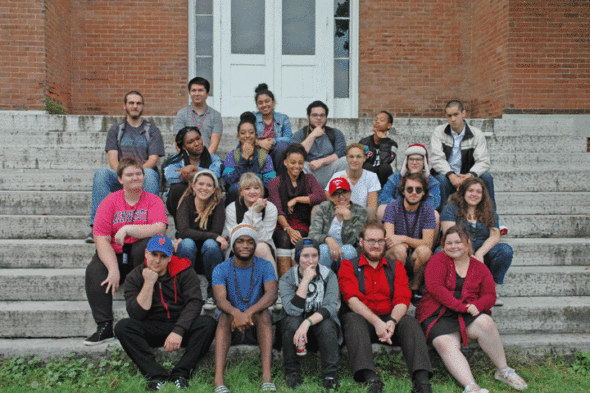
Antioch College’s new class gathered on the steps of Main Hall in early October for their first group photo. Twenty-eight strong (most of whom appear above), the class is notably diverse. Students hail from 10 states, have varied interests and almost half are students of color. (Photo by Audrey Hackett)
2017 year in review: higher education in the Village
- Published: January 4, 2018
Antioch College
Antioch College graduated its third class since reopening in 2011, and welcomed the 28 members of the class of 2021. New college-wide planning efforts sought to increase financial stability and resiliency in the face of slower-than-expected enrollment and tuition growth. Alumni giving remained strong, and a “new generations” scholarship program was launched.
New scholarships announced
Antioch College announced its New Generations Scholarship Program in January, offering substantial scholarships to students who might not otherwise be able to attend the college. Villagers Al and Donna Denman gave an inaugural gift to fund three students for all four years at the college in the amount of $35,000 each year, beginning in the fall of 2017. Al Denman was a longtime philosophy professor at Antioch, and the couple has lived in Yellow Springs for many years.
Review celebrates 75 years
The Antioch Review celebrated its 75th anniversary in late 2016 and early 2017, with the second of a two-volume anniversary special issue coming out last spring. Founded in 1941, the Review is one of the nation’s oldest continuously publishing literary magazines, and has received many top literary prizes.
One year after accreditation
Antioch continued to reinvent itself in the year following its July 2016 accreditation. Last spring, college leaders, faculty and students spoke with the News regarding challenges and opportunities the new Antioch faces. Chief among the challenges are shortfalls in enrollment and tuition growth, which President Tom Manley said were partly the result of unrealistic prior growth projections. Manley is now in the second year of his presidency.
Through college-wide brainstorming sessions and other means, college leaders sought to develop a new framework for Antioch’s financial stability and resiliency. These efforts include a revamped curriculum, new marketing and recruitment strategies, a deepened commitment to shared governance and new ways of integrating the college’s “curricular assets,” such as Glen Helen and WYSO, into the academic program.
Financially, Antioch continued to rely heavily on philanthropic gifts, the vast majority of which came from alumni. In a July press release, the college announced it had ended fiscal year 2017 with $12.75 in contributed revenue, including a $1 million gift from villagers Maureen Lynch and Richard Lapedes, and a $2 million gift from alumnus Matthew Morgan.
‘Colloquia’ shares student projects
More than 50 graduating seniors in the sciences, social sciences, arts and humanities participated in Colloquia 2017, a public “sharing out” of senior projects with the campus and wider community.
Third commencement
Seventy-six newly minted graduates walked over the mound on June 24, the college’s third commencement ceremony since reopening. Assistant Professor of History Kevin McGruder gave the commencement address, having been selected for the honor by the graduating class.
New class, small but diverse
In October, Antioch welcomed the seventh class since reopening in 2011. This year’s incoming class is small but diverse, with just 28 students hailing from 10 states. Nearly half are students of color, and about a quarter are the first in their families to attend college.
This year’s enrollment fell significantly short of the college’s goal of 60, following a similar shortfall in 2016. Total enrollment stood at 135 as of this fall. In an effort to reinvigorate recruitment, college leaders in September hired Gariot Louima, Antioch’s former communications chief, as the new dean of admissions and external relations.
Antioch University
and AUM
Antioch University slowed down on plans to sell its Yellow Springs campus, with the future of the Antioch University Midwest, or AUM, building still undecided by year’s end. Meanwhile, AUM launched new partnerships with area community colleges.
‘3-plus-1’ program launched
AUM launched a “3-plus-1” program with Southern State Community College, located in Hillsboro, Ohio, during the spring semester. The program allows students to earn a bachelor’s degree with three years of technical classes at Southern and one year of liberal arts studies at AUM. Degrees are offered in areas including agriculture, criminal justice, information technology and social services.
AUM now has three “3-plus-1” programs in place — with Southern, Sinclair Community College and Clark State Community College. As of this fall, the three programs enrolled about 20 students, according to university officials, with more enrollment growth expected.
Future of Yellow Springs campus
The future of Antioch University’s Yellow Springs campus came into question this year.
In a May 30 letter from Interim Chancellor Bill Groves, the university announced plans to sell the AUM campus, a 94,000 square-foot building on the western edge of the village.
In an interview this week, however, Groves, who was recently named permanent chancellor of Antioch University, said the future of the building was still up in the air. The university has not begun to market the property, though it has engaged a broker, and has taken a step back to reevaluate its facility needs across the whole five-campus university system in light of plans to grow students and programs nationally, Groves said.
The Yellow Springs News encourages respectful discussion of this article.
You must login to post a comment.
Don't have a login? Register for a free YSNews.com account.













No comments yet for this article.